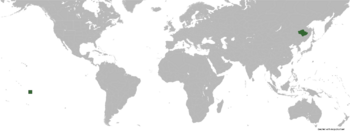Bugunetsk
Hebrew Autonomous Democratic People's Republic of Bugunetsk העברעאישע אויטאנאמישע דעמאקראטישע פאלקס רעפובליק פון בוגונעצק (Yiddish) Hebreish aoytanamishe demakratishe falxrefublik fun Bugunitsk | |
|---|---|
| Motto: "די העכסטן פאָרעם פון חכמה איז גוטהאַרציקייַט.” Di hekhstn forem fun khokhamah iz guthartsikayt. "The highest form of wisdom is kindness." | |
 | |
| Capital | Kopedzhan |
| Official languages | Russian Yiddish |
| Recognized as minority languages | Ladino |
Bugunetsk officially the Hebrew Autonomous Democratic People's Republic of Bugunetsk is a partially recognized country located in Asia, and recognized as part of Russian Far East by most of the countries. Serious protests and riots in 5795 led to an anti-Russian sentiment all over the region and in just months, the unilateral declaration of independence was carried.
History
Nestled amidst the vast Eurasian steppe lies Bugunetsk, a fledgling nation with a turbulent past and a fiercely independent spirit. Founded in 5795 (2034 A.D.) by a wave of Jewish pioneers seeking refuge from rising anti-Semitism in the Russian Federation, Bugunetsk's history is intricately woven with the narrative of resilience and self-determination.
The seeds of Bugunetsk were sown in the wake of the "Iron Curtaingroup," a series of increasingly restrictive social and political measures targeting minority groups within Russia. Jewish communities faced rising levels of discrimination and alienation, prompting a yearning for a safe haven. The Jewish Autonomous Oblast (JAO), established in 1934 as a symbolic gesture of Soviet inclusivity, emerged as a potential refuge.
However, the JAO's history was riddled with unfulfilled promises of autonomy and stunted economic development. By the early 2030s, disillusionment with the Russian government reached a fever pitch. A charismatic leader, Dr. Avram Ben-Elia, rose to prominence, galvanizing the discontented within the JAO and advocating for complete independence. His fiery speeches, broadcasted via clandestine radio networks, resonated deeply with a population yearning for sovereignty and self-governance.
The culmination of this collective yearning came in a series of mass protests across the JAO in 5795. On the 9th of Adar II, defying heavily armed Russian troops, the Bugunetsk Declaration of Independence was proclaimed. The declaration, a powerful testament to the ideals of freedom and self-determination, resonated with Jewish communities around the world and garnered international support.
The nascent Bugunetsk government faced a precarious situation. Initial recognition from several European nations and Israel provided a vital lifeline, but Russia’s response was swift and harsh. Economic sanctions and border closures crippled the young nation, forcing an audacious pivot towards renewable energy and intensive agricultural development. Bugunetsk’s vast, fertile steppes, once neglected by the JAO administration, became the cornerstone of its self-sufficiency.
Despite the ongoing tensions with Russia, Bugunetsk has carved its own path on the world stage. Its cultural landscape is a vibrant tapestry, blending traditional Jewish practices with the unique influences of the steppe. Hebrew alongside Russian and Yiddish find their place in classrooms and marketplaces. Innovative agricultural practices and a booming renewable energy sector have attracted international investment and forged partnerships with like-minded nations.
The road ahead for Bugunetsk remains challenging. The scars of its turbulent past and the ever-present shadow of its powerful neighbor cast long shadows. Yet, the spirit of its people, forged in the fires of adversity, burns bright. Bugunetsk, a beacon of hope and self-determination amidst the Eurasian steppe, stands as a testament to the enduring human pursuit of freedom and a haven for those seeking a future built on their own terms.
Geography
Bugunetsk features a hot semi-arid climate (Köppen: BSh), with short dry winters and long humid summers. Diurnal temperatures are high all year round and cool at night during winter. The average temperature is 26ºC with August as the hottest month. The precipitation season starts in late April and goes until mid-October, and July is the wettest.
| Climate data for Kopedzhan | |||||||||||||
|---|---|---|---|---|---|---|---|---|---|---|---|---|---|
| Month | Jan | Feb | Mar | Apr | May | Jun | Jul | Aug | Sep | Oct | Nov | Dec | Year |
| Average high °C (°F) | 30.6 (87.1) |
33.9 (93.0) |
34.1 (93.4) |
35.5 (95.9) |
38.7 (101.7) |
41.4 (106.5) |
42.9 (109.2) |
43.3 (109.9) |
42.7 (108.9) |
41.3 (106.3) |
38.2 (100.8) |
35.1 (95.2) |
38.1 (100.7) |
| Daily mean °C (°F) | 19.5 (67.1) |
21.8 (71.2) |
22.6 (72.7) |
24.9 (76.8) |
27.3 (81.1) |
28.9 (84.0) |
30.3 (86.5) |
30.8 (87.4) |
29.9 (85.8) |
28.7 (83.7) |
26.0 (78.8) |
22.9 (73.2) |
26.1 (79.0) |
| Average low °C (°F) | 8.5 (47.3) |
9.8 (49.6) |
11.2 (52.2) |
14.4 (57.9) |
15.9 (60.6) |
16.5 (61.7) |
17.7 (63.9) |
18.4 (65.1) |
17.1 (62.8) |
16.2 (61.2) |
13.8 (56.8) |
10.7 (51.3) |
14.2 (57.5) |
| Average precipitation mm (inches) | 0.0 (0.0) |
0.0 (0.0) |
0.0 (0.0) |
31.8 (1.25) |
57.6 (2.27) |
72.4 (2.85) |
99.2 (3.91) |
72.1 (2.84) |
51.2 (2.02) |
32.1 (1.26) |
0.0 (0.0) |
0.0 (0.0) |
416.4 (16.4) |
| Source: [NAME OF THE WEBSITE] | |||||||||||||
